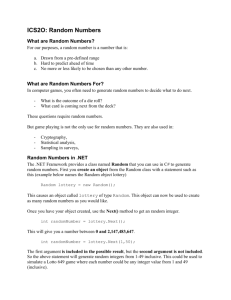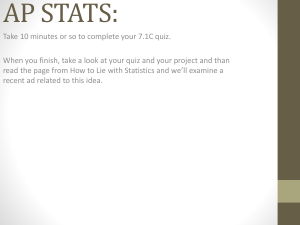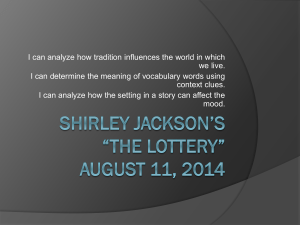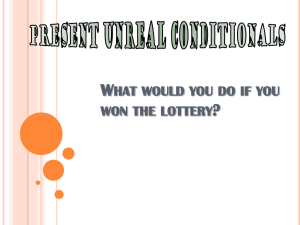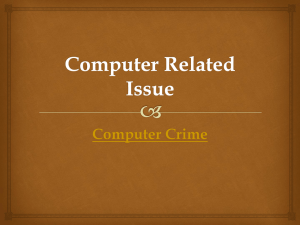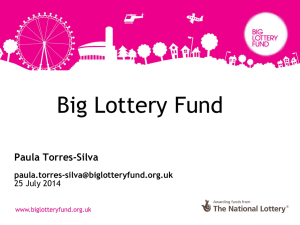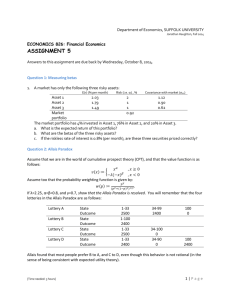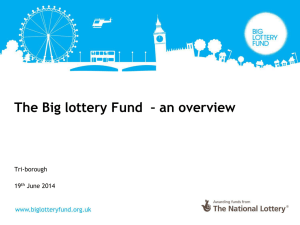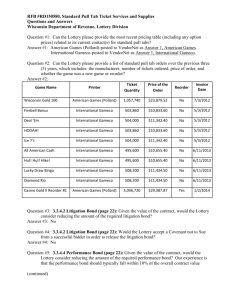The Lottery
advertisement
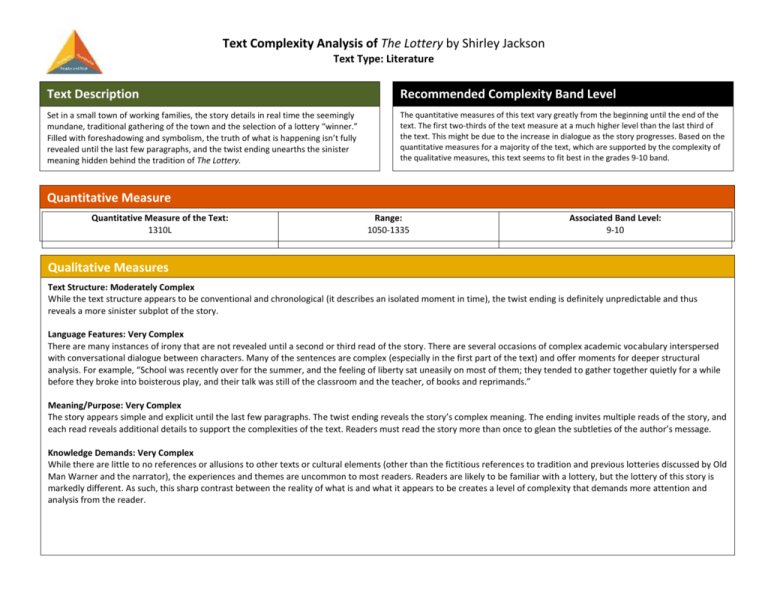
Text Complexity Analysis of The Lottery by Shirley Jackson Text Type: Literature Text Description Recommended Complexity Band Level Set in a small town of working families, the story details in real time the seemingly mundane, traditional gathering of the town and the selection of a lottery “winner.” Filled with foreshadowing and symbolism, the truth of what is happening isn’t fully revealed until the last few paragraphs, and the twist ending unearths the sinister meaning hidden behind the tradition of The Lottery. The quantitative measures of this text vary greatly from the beginning until the end of the text. The first two-thirds of the text measure at a much higher level than the last third of the text. This might be due to the increase in dialogue as the story progresses. Based on the quantitative measures for a majority of the text, which are supported by the complexity of the qualitative measures, this text seems to fit best in the grades 9-10 band. Quantitative Measure Quantitative Measure of the Text: 1310L Range: 1050-1335 Associated Band Level: 9-10 Qualitative Measures Text Structure: Moderately Complex While the text structure appears to be conventional and chronological (it describes an isolated moment in time), the twist ending is definitely unpredictable and thus reveals a more sinister subplot of the story. Language Features: Very Complex There are many instances of irony that are not revealed until a second or third read of the story. There are several occasions of complex academic vocabulary interspersed with conversational dialogue between characters. Many of the sentences are complex (especially in the first part of the text) and offer moments for deeper structural analysis. For example, “School was recently over for the summer, and the feeling of liberty sat uneasily on most of them; they tended to gather together quietly for a while before they broke into boisterous play, and their talk was still of the classroom and the teacher, of books and reprimands.” Meaning/Purpose: Very Complex The story appears simple and explicit until the last few paragraphs. The twist ending reveals the story’s complex meaning. The ending invites multiple reads of the story, and each read reveals additional details to support the complexities of the text. Readers must read the story more than once to glean the subtleties of the author’s message. Knowledge Demands: Very Complex While there are little to no references or allusions to other texts or cultural elements (other than the fictitious references to tradition and previous lotteries discussed by Old Man Warner and the narrator), the experiences and themes are uncommon to most readers. Readers are likely to be familiar with a lottery, but the lottery of this story is markedly different. As such, this sharp contrast between the reality of what is and what it appears to be creates a level of complexity that demands more attention and analysis from the reader. Text Complexity Analysis of The Lottery by Shirley Jackson Text Type: Literature Considerations for Reader and Task Possible Major Instructional Areas of Focus (include 3-4 CCS Standards) for this Text: RL.9-10.2 - Determine a theme or central idea of a text and analyze in detail its development over the course of the text, including how it emerges and is shaped and refined by specific details; provide an objective summary of the text. Discuss possible themes of the story and then have students trace a theme over the course of the story by identifying specific details. RL.9-10.3 - Analyze how complex characters (e.g., those with multiple or conflicting motivations) develop over the course of a text, interact with other characters, and advance the plot or develop the theme. Have students select a character from the story and identify three details (i.e., description of actions or dialogue) that “reveal” the character. For each detail, have students describe which characters are involved, how the detail relates to the events or message of the story, and what that details reveals about the character. RL.9-10.5 - Analyze how an author’s choices concerning how to structure a text, order events within it (e.g., parallel plots), and manipulate time (e.g., pacing, flashbacks) create such effects as mystery, tension, or surprise. After reading the story once, have students create a T-chart with “lottery” on the left side and “The Lottery” on the right side. In small groups, have students complete the left side of the chart, identifying characteristics of a traditional lottery. As students reread the story, ask them to locate “clues” that hint at the surprise ending and add those to the T-chart. Ask them to organize their clues on by listing them next to those that contradict the characteristics of a traditional lottery. Using the T-chart, discuss how the author is able to keep readers “in the dark” until the end of the story. Below are factors to consider with respect to the reader and task: Potential Challenges this Text Poses: To understand and appreciate the surprise ending of this story, students must understand the events leading up to the ending. Differentiation/Supports for Students: While it is typically better to read a text in its entirety once through with minimal interruptions, students who are likely to struggle reading this text would benefit to reading it in chunks with checks for understanding (via text-dependent questions) interspersed throughout. This will allow the surprise of the ending to have the same amount of power for all students regardless of their independent reading ability. While it may be tempting to engage students in activities in advance of reading that discuss the characteristics of a lottery, the power of the ending depends on surprise. Spending time up front discussing a lottery would unnecessarily prepare students to anticipate something is different about this lottery, which would likely diminish the surprise. This type of discussion is useful for the second or third read of the text (see RL.9-10.5 to the left) when students are deeply analyzing the text for how the author creates irony through the text’s structure. For learning extension: Read this novel as a part of a text set that includes other texts that explore similar issues (e.g., “Taking a stand is often difficult and costly, but not taking a stand more often extracts a greater toll.”) Some examples of additional texts include the following. Using excerpts (rather than the novels in their entireties) may be necessary. o Animal Farm, George Orwell o “Conscientious Objector,” Edna St. Vincent Millay o Excerpt from The Jungle, Upton Sinclair o “Speech to the Second Virginia Convention” by Patrick Henry (CCSS Exemplar) o Documents Related to Brown v. Board of Education (U.S. Government Archives) o “The Children’s Story,” James Clavell o “The Ones Who Walk Away from Omelas,” Ursula LeGuin
